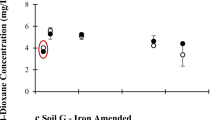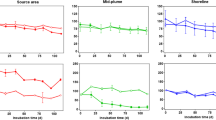Abstract
1,4-Dioxane (dioxane) is relatively recalcitrant to biodegradation, and its physicochemical properties preclude effective removal from contaminated groundwater by volatilization or adsorption. Through this microcosm study, we assessed the biodegradation potential of dioxane for three sites in California. Groundwater and sediment samples were collected at various locations at each site, including the presumed source zone, middle and leading edge of the plume. A total of 16 monitoring wells were sampled to prepare the microcosms. Biodegradation of dioxane was observed in 12 of 16 microcosms mimicking natural attenuation within 28 weeks. Rates varied from as high as 3,449 ± 459 µg/L/week in source-zone microcosms to a low of 0.3 ± 0.1 µg/L/week in microcosms with trace level of dioxane (<10 µg/L as initial concentration). The microcosms were spiked with 14C-labeled dioxane to assess the fate of dioxane. Biological oxidizer-liquid scintillation analysis of bound residue infers that 14C-dioxane was assimilated into cell material only in microcosms exhibiting significant dioxane biodegradation. Mineralization was also observed per 14CO2 recovery (up to 44 % of the amount degraded in 28 weeks of incubation). Degradation and mineralization activity significantly decreased with increasing distance from the contaminant source area (p < 0.05), possibly due to less acclimation. Furthermore, both respiked and repeated microcosms prepared with source-zone samples from Site 1 confirmed relatively rapid dioxane degradation (i.e., 100 % removal by 20 weeks). These results show that indigenous microorganisms capable of degrading dioxane are present at these three sites, and suggest that monitored natural attenuation should be considered as a remedial response.






Similar content being viewed by others
References
Aelion CM, Dobbins DC, Pfaender FK (1989) Adaptation of aquifer microbial communities to the biodegradation of xenobiotic compounds—influence of substrate concentration and preexposure. Environ Toxicol Chem 8(1):75–86. doi:10.1897/1552-8618(1989)8
Alvarez PJ, Illman WA (2006) Bioremediation and natural attenuation: process fundamentals and mathematical models. Wiley, Hoboken
Anderson RH, Anderson JK, Bower PA (2012) Co-occurrence of 1,4-dioxane with trichloroethylene in chlorinated solvent groundwater plumes at US Air Force installations: fact or fiction. Integr Environ Assess Manag 8(4):731–737. doi:10.1002/ieam.1306
Andreozzi R, Caprio V, Insola A, Marotta R (1999) Advanced oxidation processes (AOP) for water purification and recovery. Catal Today 53(1):51–59. doi:10.1016/S0920-5861(99)00102-9
Beckles DM, Chen W, Hughes JB (2007) Bioavailability of polycyclic aromatic hydrocarbons sequestered in sediment: microbial study and model prediction. Environ Toxicol Chem 26(5):878–883. doi:10.1897/06-410R.1
Brode J, Fotouhi F, Kolon S (2005) Ultraviolet and hydrogen peroxide treatment removes 1,4-dioxane from multiple aquifers. Technology News and Trends. http://www.clu-in.org/products/newsltrs/tnandt/view.cfm?issue=0105.cfm. Accessed 27 Sept 2014
California EPA (2014) http://www.waterboards.ca.gov/drinking_water/certlic/drinkingwater/14-Dioxane.shtml. Accessed 27 Sept 2014
Chiang SYD, Mora R, Diguiseppi WH, Davis G, Sublette K, Gedalanga P, Mahendra S (2012) Characterizing the intrinsic bioremediation potential of 1,4-dioxane and trichloroethene using innovative environmental diagnostic tools. J Environ Monit 14(9):2317–2326. doi:10.1039/C2em30358b
Cronk G (2008) Case study comparison of multiple activation methods for sodium persulfate ISCO treatment. In: Sixth international conference on remediation of chlorinated and recalcitrant compounds, Monterey. Battelle Press, Columbus
DiGuiseppi W, Whitesides C (2007) Treatment options for remediation of 1,4-dioxane in groundwater. Environ Eng Appl Res Pract 2:1–7
Dombrowski PM, Weir BA, Kelly KM, Brown J (2010) Fast-track remedial design of full-scale ISCO application using pilot scale testing and field screening parameters. In: Proceedings of the annual international conference on soils, sediments, water and energy, 2010
Doucette WJ, Wheeler BR, Chard JK, Bugbee B, Naylor CG, Carbone JP, Sims RC (2005) Uptake of nonylphenol and nonylphenol ethoxylates by crested wheatgrass. Environ Toxicol Chem 24(11):2965–2972. doi:10.1897/05-171r.1
Epa US (2006) treatment technologies for 1,4-dioxane: fundamentals and field applications. EPA, Cincinnati
EPA US (2010) http://www.epa.gov/iris/subst/0326.htm. Accessed 27 Sept 2014
EPA US (2013) The third unregulated contaminant monitoring rule (UCMR 3): data summary. EPA, Washington DC
Houston KS, Horst J, Wroblewski G (2009) Focused in-situ chemical oxidation of chlorinated VOCs and 1,4-dioxane using sodium persulfate in fine-grained soils. Pollution Engineering. http://www.pollutionengineering.com/articles/88033. Accessed 27 Sept 2014
Huling SG, Pivetz BE (2006) In-situ chemical oxidation. Washington DC, EPA
IARC (1999) Monograph on 1,4-Dioxane. International Agency for Research on Cancer, Lyon
Kim YH, Engesser KH, Kim SJ (2007) Physiological, numerical and molecular characterization of alkyl ether-utilizing rhodococci. Environ Microbiol 9(6):1497–1510. doi:10.1111/j.1462-2920.2007.01269.x
Leahy JG, Colwell RR (1990) Microbial-degradation of hydrocarbons in the environment. Microbiol Rev 54(3):305–315
Li D, Fortner JD, Johnson DR, Chen C, Li QL, Alvarez PJJ (2010a) Bioaccumulation of C-14(60) by the earthworm Eisenia fetida. Environ Sci Technol 44(23):9170–9175. doi:10.1021/Es1024405
Li M, Fiorenza S, Chatham JR, Mahendra S, Alvarez PJJ (2010b) 1,4-Dioxane biodegradation at low temperatures in Arctic groundwater samples. Water Res 44(9):2894–2900. doi:10.1016/j.watres.2010.02.007
Li M, Conlon P, Fiorenza S, Vitale RJ, Alvarez PJJ (2011) Rapid analysis of 1,4-dioxane in groundwater by frozen micro-extraction with gas chromatography/mass spectrometry. Ground Water Monit R 31(4):70–76. doi:10.1111/j.1745-6592.2011.01350.x
Li M, Mathieu J, Liu Y, Van Orden ET, Yang Y, Fiorenza S, Alvarez PJJ (2013a) The abundance of tetrahydrofuran/dioxane monooxygenase genes (thmA/dxmA) and 1,4-dioxane degradation activity are significantly correlated at various impacted aquifers. Environ Sci Technol Lett 1(1):122–127. doi:10.1021/ez400176h
Li M, Mathieu J, Yang Y, Fiorenza S, Deng Y, He Z, Zhou J, Alvarez PJJ (2013b) Widespread distribution of soluble di-iron monooxygenase (SDIMO) genes in arctic groundwater impacted by 1,4-dioxane. Environ Sci Technol 47(17):9950–9958. doi:10.1021/es402228x
Macdonald JA (2000) Peer reviewed: evaluating natural attenuation for groundwater cleanup. Environ Sci Technol 34(15):346A–353A. doi:10.1021/es003359w
Mahendra S, Alvarez-Cohen L (2006) Kinetics of 1,4-dioxane biodegradation by monooxygenase-expressing bacteria. Environ Sci Technol 40(17):5435–5442. doi:10.1021/Es060714v
Mahendra S, Petzold CJ, Baidoo EE, Keasling JD, Alvarez-Cohen L (2007) Identification of the intermediates of in vivo oxidation of 1,4-dioxane by monooxygenase-containing bacteria. Environ Sci Technol 41(21):7330–7336. doi:10.1021/Es0705745
Miller CM, Valentine RL, Roehl ME, Alvarez PJJ (1996) Chemical and microbiological assessment of pendimethalin-contaminated soil after treatment with Fenton’s reagent. Water Res 30(11):2579–2586
Mohr T, Stickney J, DiGuiseppi W (2010) Environmental investigation and remediation: 1,4-dioxane and other solvent stabilizers. CRC Press, Boca Raton
Parales RE, Adamus JE, White N, May HD (1994) Degradation of 1,4-dioxane by an Actinomycete in pure culture. Appl Environ Microbiol 60(12):4527–4530
Sales CM, Grostern A, Parales JV, Parales RE, Alvarez-Cohen L (2013) Oxidation of the cyclic ethers 1,4-dioxane and tetrahydrofuran by a monooxygenase in two Pseudonocardia species. Appl Environ Microbiol 79(24):7702–7708. doi:10.1128/Aem.02418-13
Schwarzenbach R, Gschwend P, Imboden D (2003) Environmental organic chemistry. Wiley
Sei K, Kakinoki T, Inoue D, Soda S, Fujita M, Ike M (2010) Evaluation of the biodegradation potential of 1,4-dioxane in river, soil and activated sludge samples. Biodegradation 21(4):585–591. doi:10.1007/s10532-010-9326-3
Thiemer B, Andreesen JR, Schrader T (2003) Cloning and characterization of a gene cluster involved in tetrahydrofuran degradation in Pseudonocardia sp strain K1. Arch Microbiol 179(4):266–277
Vainberg S, McClay K, Masuda H, Root D, Condee C, Zylstra GJ, Steffan RJ (2006) Biodegradation of ether pollutants by Pseudonocardia sp strain ENV478. Appl Environ Microbiol 72(8):5218–5224
Wang HY, Ye QF, Yue L, Yu ZY, Han AL, Yang ZM, Lu L (2009) Kinetics of extractable residue, bound residue and mineralization of a novel herbicide, ZJ0273, in aerobic soils. Chemosphere 76(8):1036–1040. doi:10.1016/j.chemosphere.2009.04.051
Yang Y, Li M, Michels C, Moreira-Soares H, Alvarez PJ (2014) Differential sensitivity of nitrifying bacteria to silver nanoparticles in activated sludge. Environ Toxicol Chem. doi:10.1002/etc.2678
Acknowledgments
We thank Dr. Dong Li (Rice University) for her assistance on biological oxidizer.
Conflict of interest
The authors declare no competing financial interest.
Author information
Authors and Affiliations
Corresponding author
Rights and permissions
About this article
Cite this article
Li, M., Van Orden, E.T., DeVries, D.J. et al. Bench-scale biodegradation tests to assess natural attenuation potential of 1,4-dioxane at three sites in California. Biodegradation 26, 39–50 (2015). https://doi.org/10.1007/s10532-014-9714-1
Received:
Accepted:
Published:
Issue Date:
DOI: https://doi.org/10.1007/s10532-014-9714-1




